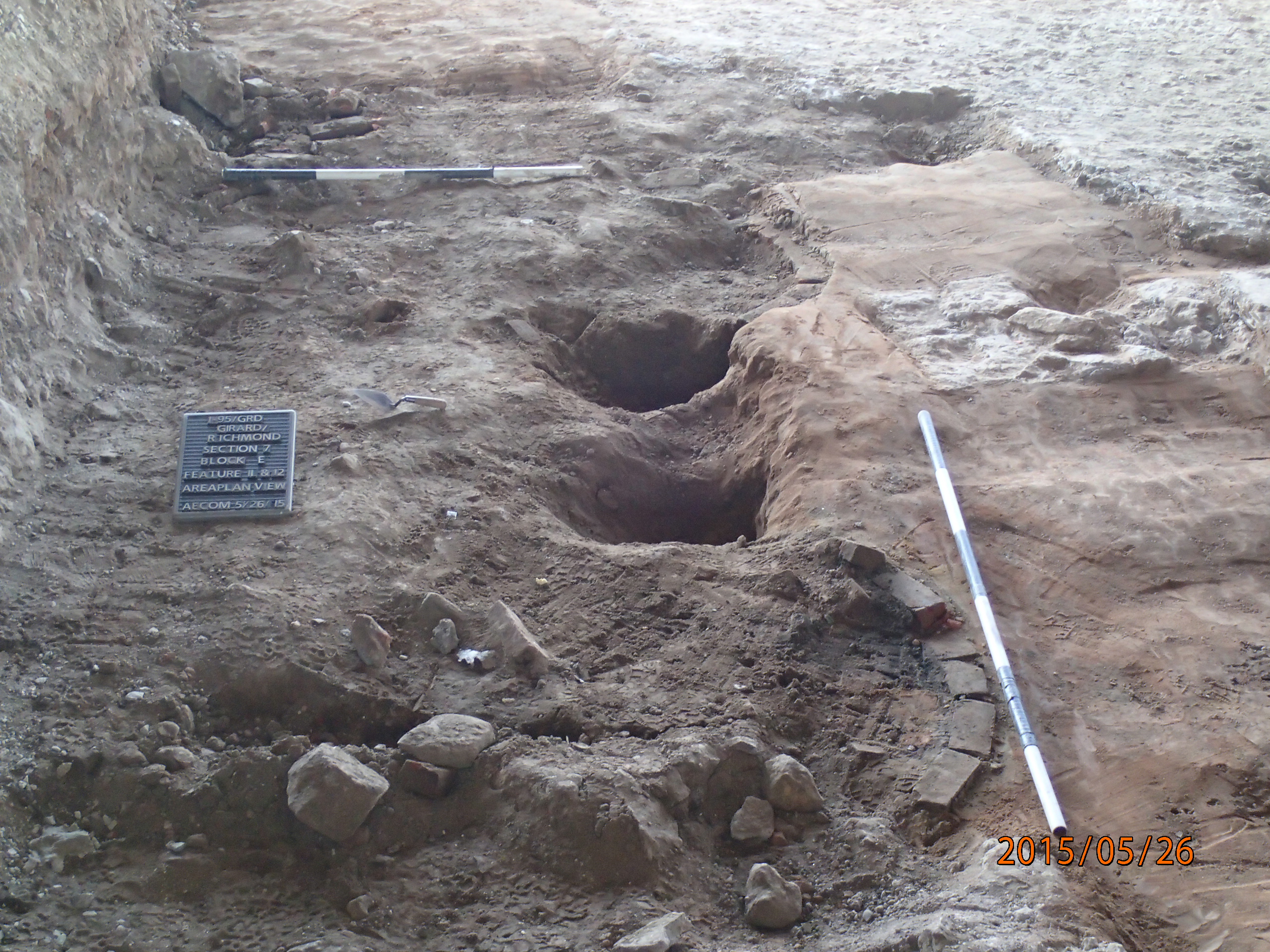Site Page
Hunter

Explore
Hunter:
| Site Name | Hunter |
| PASS# | 36PH0226 |
| Image | 1 image site overview |
| Dates of Excavation | 2015 |
| Phase of Excavation | Phase II and III |
| Number of Units | 2 |
| Number of Features | 2 |
| Associated Periods | Mid-nineteenth to late nineteenth century |
| Site Acreage | 0.13 |
It was first encountered when a large excavation block (Block E) was opened in this area while searching for intact residential backyard spaces. Block E measured approximately 40 feet from north to south by 35 feet from east to west. Due to the potential presence of intact historic soils, two excavation units were placed within this trench. These units confirmed that this area was heavily disturbed during the late historic and modern periods. Block E encompassed the northern edge of the late-nineteenth-century Perseverance Ironworks, which heavily disturbed large portions of the areas to the north of York Street. Additionally, a modern storm sewer impacted the northern portion of Block E itself. Fortunately, a narrow strip of the two adjoining backyards was left relatively intact. Although no intact soils were encountered, portions of two circular brick privy shafts were found intact.
The two privy shafts were encountered within Block E and located at the rear of the adjoining backyards of the former residences at 2416 Richmond and 2415 Salmon. Heavy disturbances to the north were evident, but intact subsoil was encountered to the south of the shafts. A foundation wall south of the shafts is likely an element of the Perseverance Ironworks.
Feature 11 was a 4-foot-diameter circular brick shaft with the upper portion of its northern half impacted by the aforementioned storm sewer pipe. The uppermost layer of Feature 11 showed evidence of this modern impact. Many of the layers below can be attributed to the capping of this privy at the end of its use. At the base of the shaft, approximately 1 foot of very dark and organic primary fill was encountered with materials and soil the residents of 2415 Salmon Street deposited in the privy during the mid to late nineteenth century.
Feature 12 was a shaft similar to Feature 11. Even though the sewer trench and a disused inlet greatly impacted the upper portions of this shaft, the lower portion was left untouched. Fortunately, the lower parts of historic privies are most likely to contain primary deposits that are directly related to their use, while the upper parts are usually related to the capping of privies at the end of their useful lives. In the case of Feature 12, such primary deposits were left intact and contained artifacts relating to the mid- and late-nineteenth-century residents of 2416 Richmond Street.
Site Page
Hunter

| Site Name | Hunter |
| PASS# | 36PH0226 |
| Image | 1 image site overview |
| Dates of Excavation | 2015 |
| Phase of Excavation | Phase II and III |
| Number of Units | 2 |
| Number of Features | 2 |
| Associated Periods | Mid-nineteenth to late nineteenth century |
| Site Acreage | 0.13 |
It was first encountered when a large excavation block (Block E) was opened in this area while searching for intact residential backyard spaces. Block E measured approximately 40 feet from north to south by 35 feet from east to west. Due to the potential presence of intact historic soils, two excavation units were placed within this trench. These units confirmed that this area was heavily disturbed during the late historic and modern periods. Block E encompassed the northern edge of the late-nineteenth-century Perseverance Ironworks, which heavily disturbed large portions of the areas to the north of York Street. Additionally, a modern storm sewer impacted the northern portion of Block E itself. Fortunately, a narrow strip of the two adjoining backyards was left relatively intact. Although no intact soils were encountered, portions of two circular brick privy shafts were found intact.
The two privy shafts were encountered within Block E and located at the rear of the adjoining backyards of the former residences at 2416 Richmond and 2415 Salmon. Heavy disturbances to the north were evident, but intact subsoil was encountered to the south of the shafts. A foundation wall south of the shafts is likely an element of the Perseverance Ironworks.
Feature 11 was a 4-foot-diameter circular brick shaft with the upper portion of its northern half impacted by the aforementioned storm sewer pipe. The uppermost layer of Feature 11 showed evidence of this modern impact. Many of the layers below can be attributed to the capping of this privy at the end of its use. At the base of the shaft, approximately 1 foot of very dark and organic primary fill was encountered with materials and soil the residents of 2415 Salmon Street deposited in the privy during the mid to late nineteenth century.
Feature 12 was a shaft similar to Feature 11. Even though the sewer trench and a disused inlet greatly impacted the upper portions of this shaft, the lower portion was left untouched. Fortunately, the lower parts of historic privies are most likely to contain primary deposits that are directly related to their use, while the upper parts are usually related to the capping of privies at the end of their useful lives. In the case of Feature 12, such primary deposits were left intact and contained artifacts relating to the mid- and late-nineteenth-century residents of 2416 Richmond Street.